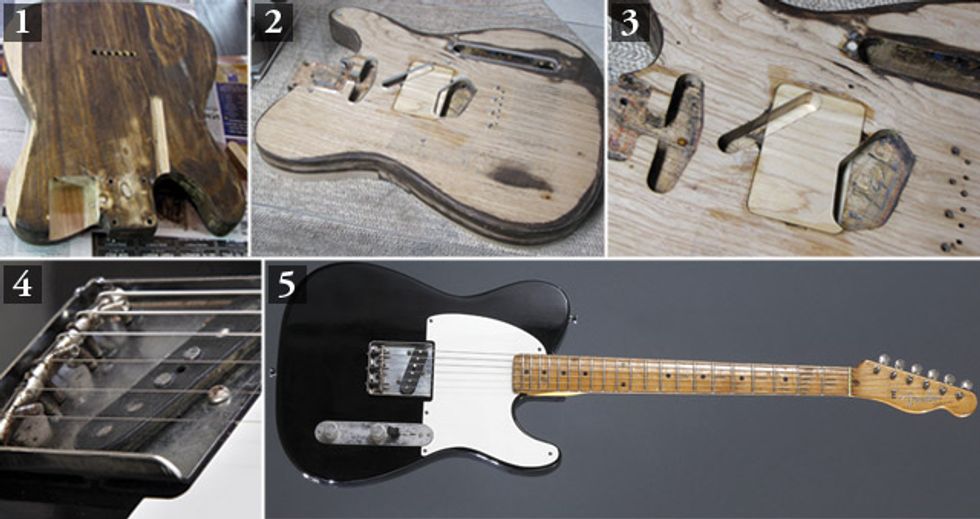1. To repair the hacked-up body of this ’56 Esquire, I cut replacement pieces from old ash and shaped them to graft back into the guitar. 2. Today’s commercial
1. To repair the hacked-up body of this ’56 Esquire, I cut replacement pieces from old ash and
shaped them to graft back into the guitar. 2. Today’s commercial routing templates have larger
pickup and channel holes than Fender used in 1956, so I had to make my own custom acrylic
template using a mint ’51 Esquire as a reference. 3. The ’56 body after patching and routing. 4.
We auditioned compensated brass replacement saddles, but returned to these original, noncompensated
steel saddles. They just sounded better on this guitar. 5. Back from the dead: The
restored ’56 Esquire in all its vibey glory.
Never have I seen a rare guitar come to us so completely destroyed. This ’56 Esquire—a real piece of Fender history— had been mangled beyond comprehension.
Someone had drilled screws (some as long as 4") into the body to hold previously broken sections of ash wood into place, and then added insult to injury by slapping deep wads of grayish-blue Bondo putty on it. The body was stained shamrock green, and it looked as if the original finish had been removed using a power sander and 60-grit paper because the Esquire’s distinctive edges were rounded over. Despite all of this, I still could not bring myself to throw out the body and trade it in for a replacement.
The original bridge and neck pickups were intact, but they too were in need of in-depth restoration. Admittedly, I was getting some odd looks in the shop. The general vibe was, “Are you really sure you’re making the right call taking this project?” But the client brought the guitar in to get restored, so that’s just what we did.
Over the years, I’ve set aside old, small scraps of ash at the shop, and they sure came in handy for doing grafts into the damaged areas of this broken-down body. The original body routes from the early ’50s were definitely smaller compared to any templates in production today. I did not want to enlarge the pickup routes and other channels to today’s standards, so I took a ’51 Fender Esquire, carefully measured it, and designed a full-body acrylic routing template from material I purchased at Home Depot. My reference ’51 was in mint condition, so as you can imagine, I used extreme caution as I measured each route.
After the ash grafts were glued into a laminate, I used a plunge router to finalize the cut and then feathered in the new wood pieces. Once I’d repaired the body, I knew it needed to be finished in an opaque color to cover the grafted sections of wood. We chose black, and decided to spray a nitrocellulose finish to mimic what was used in ’56. I got my finishing supplies and tools from Stewart McDonald (stewmac.com).
We couldn’t save the bridge pickup coil because the inner wire was corroded around the magnetic pole pieces. So we rewound it and then cosmetically aged the solder joints to make them appear vintage. As a final touch, we rewrapped the original outer rope around the coil to give it that “never been touched” look.
There were a few issues with the neck. Its frets were destroyed, it needed a new nut, and the fretboard had a couple of 1/4" holes drilled into the wood. The final step to restoring the neck was finding the correct year of decal that was accurate to the very last detail. With patience and tenacity, and by addressing the challenges one by one, we finally revived the neck as well.
Here’s an intriguing tonal insight: When the client came in to check out the completed guitar with a few of his guitar guru friends, they were pleased with the visual and sonic aspects of the resuscitated Esquire. Both acoustically and amplified, it had a full, yet chimey bell-like tone.
The client wanted us to try replacing the original hardened-steel saddles with precompensated brass saddles to improve intonation. So we did, and the sonic result was a real eye-opener. The brass saddles altered the guitar’s tone in a major way, compressing the midrange and giving the instrument a generic sound. In the past, I’ve had very good results using the compensated brass saddles, but when all of us were in the room and heard the tonal change, it was 100 percent unanimous—the original hardened- steel saddles needed to go back on.
This Esquire serves as a reminder that each guitar needs to be restored on an individual basis. Guitars have unique voices, so just because a specific part sounds good in one guitar, that doesn’t mean we can expect it to work as well in another.
That’s my story and I’m sticking to it!



